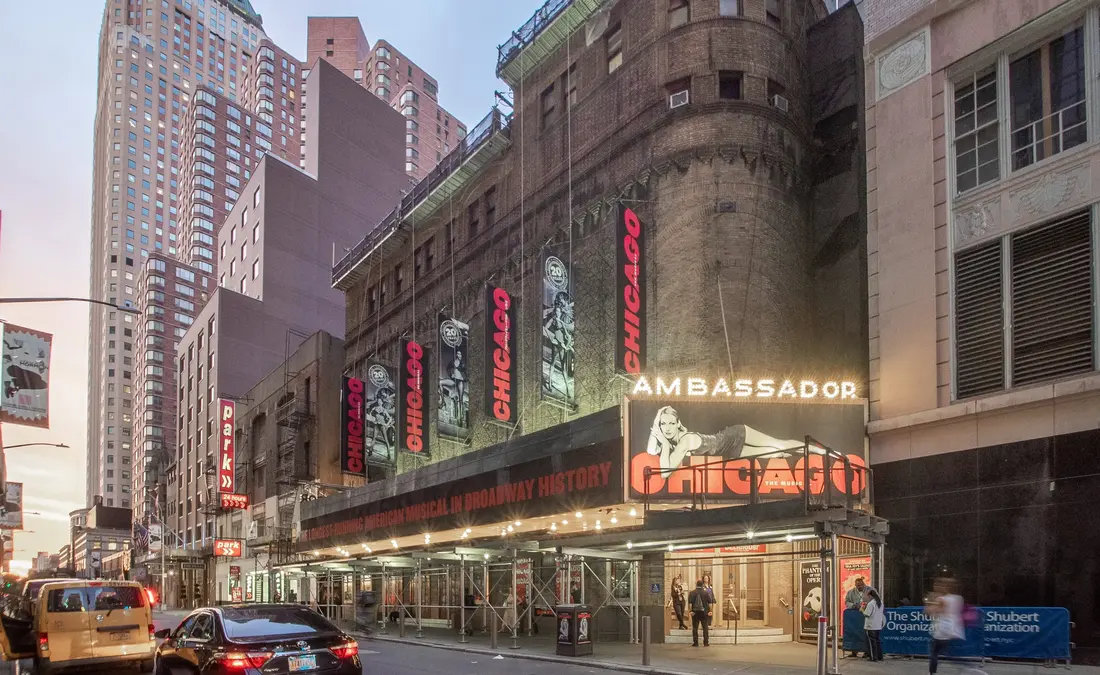Ambassador Theatre Information

The Ambassador Theatre in NYC opened in February 1921. Legendary theater architect Herbert J. Krapp was responsible for designing it. It was the first of six theaters that the Shubert brothers originally planned to build in New York City in the aftermath of World War I, though they would only get around to constructing four (rounded out by the Ritz Theatre, the Forrest Theatre, and the 49th Street Theatre).
Because the plot of land used to build the Ambassador Theatre was only about 100 by 100 feet, Krapp had to get creative when mapping it out. He eventually came up with a diagonal design to maximize the space’s potential. This decision led to Krapp designing a hexagonal auditorium for the Ambassador Theatre that differentiated it from other Broadway theaters and helped fit 1,114 seats inside.
Amazingly, it took less than three months to finish building the Ambassador Theatre. This allowed the venue to begin hosting shows at the beginning of 1921, including its first-ever production, The Rose Girl. But its first big hit was Blossom Time, which ran for over 500 performances.
Unfortunately, the Shubert brothers found success fleeting. While the Ambassador Theatre hosted a handful of intriguing shows at the start of the 1920s — such as the operetta The Dream Girl (1924), released just months after the death of notable composer Victor Herbert — the late 1920s were filled with flops that failed to connect with audiences. At this point, the theater’s future looked uncertain.
The Shubert brothers briefly turned their luck around in the early 1930s thanks to successful transfers like The Last Mile (1930) and Night of January 16th (1935). But by 1935, they decided to sell the Ambassador Theatre, and after the new owners also struggled to find a winning formula on Broadway, the theater was leased to CBS and transformed into a broadcasting studio.
Over the next 20 years, the Ambassador Theatre was used as a theater at times, but it mainly served as a movie theater and a radio and television studio. That changed in the mid-1950s when the Shubert Organization — the theatrical production company started by the Shubert brothers at the start of their respective theatrical careers — regained control of the theater and turned it back into a Broadway stage.
The second half of the 20th century saw the Ambassador Theatre host a wide range of Broadway shows, including comedies like The Loud Red Patrick (1956), one-act plays like You Know I Can’t Hear You When the Water’s Running (1967), kid-friendly performances like Paul Sills’ Story Theatre (1970), and musicals like Bring in ‘da Noise, Bring in ‘da Funk (1995).
Since the turn of the century, the Ambassador Theatre hasn’t hosted many productions. Its biggest claim to fame is that the theater started hosting the Chicago (musical) in 2003, which continues to run at the theater to this day. It became the second-longest-running Broadway production of all time in 2014.
About the Venue
The Ambassador Theatre in NYC is located at 219 West 49th Street in Midtown Manhattan’s Theater District. It was built on a relatively small plot of land that forced Herbert J. Krapp to design it on a diagonal axis. This created enough space inside the theater to fit 1,114 seats spread over two floors.
The Ambassador Theatre’s facade isn’t quite as spectacular as other Broadway theaters. Despite consisting of golden brick, its modest design doesn’t stand out so much among all the glitz and glamor. It does, however, have a prominent curved entrance that faces Broadway and adds character to its appearance.
The interior of the Ambassador Theatre is what makes it special. Just inside its front doors is a lobby that leads directly to the auditorium’s orchestra level. This auditorium is unique compared to the auditoriums found in other Broadway theaters because of its hexagonal layout. The auditorium also contains many eye-catching design elements, such as Adam-style detailing, box seats adorned with decorative arches, and a showstopping segmental proscenium arch.
The Ambassador Theatre’s auditorium helped it achieve New York City Landmark status in 1985.
Venue History
The Shubert brothers were raised in Syracuse, NY, after immigrating to the U.S. from what is now Lithuania in the 1880s. Their father was an alcoholic who was unable to work, so the brothers dropped out of school before becoming teenagers and worked to support their family. Lee and Samuel sold newspapers in front of the Bastable Theater in Syracuse, and this led to Samuel, in particular, falling in love with the theater at a young age.
Samuel landed a small part in a play put on by theatrical producer David Belasco, which led to him working behind the scenes for several Syracuse theaters. This also resulted in him and his brothers buying the Grand Opera House in Syracuse before acquiring the Herald Square Theatre in New York City by the 20th century.
The Shubert brothers eventually relocated from Syracuse to NYC and founded the Shubert Organization. They laid the groundwork for their theatrical empire throughout the 1900s and 1910s by developing many theaters in the Big Apple. However, their most ambitious move came after World War I when they expressed an interest in building half a dozen theaters on 48th and 49th Streets near Times Square.
The Ambassador Theatre was the first theater conceived by the Shubert brothers. After it was designed by Herbert J. Krapp and built in just over 80 days at the end of 1920, the venue held its grand opening on February 11, 1921. Their goal was to prove that a theater just outside the theatrical hub in NYC, which is located closer to 42nd Street, could have success.
The Ambassador Theatre in NYC wasn’t the huge immediate hit the Shubert brothers were hoping for. It did enjoy some early success with operettas like Blossom Time. It also got a boost in the mid-1920s when theatrical producers Laurence Schwab and Frank Mandel leased the theater for two years for their musical Queen High, which ran for over 350 performances.
However, the Ambassador Theatre endured its fair share of flops during the late 1920s and early 1930s, which led to the Shubert brothers leasing it to others and ultimately selling it altogether. This resulted in the Ambassador being turned into everything from a broadcasting studio to a movie theater throughout the late 1930s, 1940s, and early 1950s.
The tide started to turn in the mid-1950s when the Shubert Organization revealed that it planned to take back the Ambassador Theatre and restore it. The theater never quite lived up to the expectations the Shubert brothers had for it back at the beginning, but it did reestablish itself as a great place for people to see a Broadway show.
From the 1950s through the early 2000s, it hosted many noteworthy theatrical performances, including the following:
» The Diary of Anne Frank (1957)
» The Tenth Man (1961)
» We Bombed in New Haven (1968)
» Your Arms Too Short to Box with God (1980)
» Dreamgirls (1987)
» The Circle (1989)
» The Ride Down Mt. Morgan (2000)
» Topdog/Underdog (2002)
However, the Ambassador Theatre is best known for hosting the musical Chicago from 2003 to the present day. It’s one of the highest-grossing Broadway shows ever.
More Ambassador Theatre NYC information:
Ticket Policies:
Policies and authenticity guarantee regarding tickets from our recommended ticket marketplace.
Seating Chart:
View the standard Ambassador Theatre NYC seating map and read about different seating options.
Parking Information:
Information about the Ambassador Theatre parking options.
